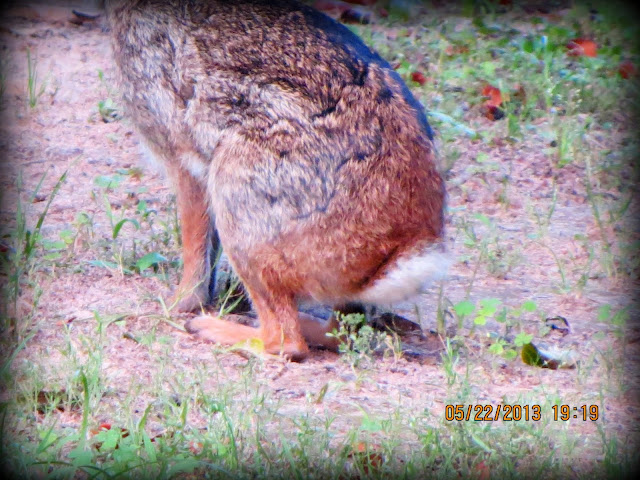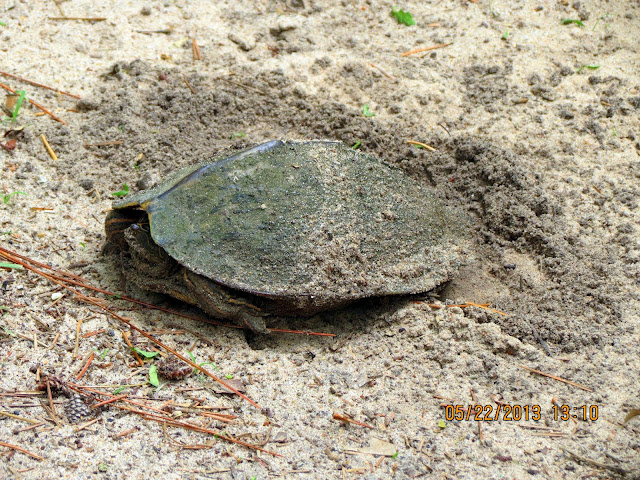Hi Everybody!!
Come meet Mr. Whiskers (the rabbit) and Myrtle (the turtle). This is the 'race', Rainbow Creek Style. In real life (as opposed to fables), the rabbit and the turtle do not interact and likely do not cross paths! Mr. Whiskers and I cross paths just about every morning at dawn. He does not fear me. We are going across the road to the same place: Billy's Garden. I am going to see a tree-free sunrise. The bunny is going to nibble in Billy's Garden! (Do not tell Billy). The turtle I came across at the back door of Kates Cabin. She has come from the creek to lay her eggs under the Yesterday, Today and Tomorrow Bush. Then she will go back to the creek. There is so much life happening here everyday on my one acre that I can not even see it all. So many things happen that nobody knows about. Throw away your couch and TV-then go see what you can really see in real life! Enjoy your photostudy from Rainbow Creek.
(Entrance to Billy's Garden!)
http://en.wikipedia.org/wiki/Swamp_rabbit
Swamp rabbit
From Wikipedia, the free encyclopedia
Appearance [edit]
S. aquaticus is similar in appearance to other cottontails, although it is among the largest members of the genus. It is generally brown, with the bottom of its stubby tail colored white. Adult male and female specimens of this species weigh between 3 and 6 pounds (1.4 and 2.7 kg). In lagomorphs, the female is commonly larger than the male.[citation needed]
Diet and nesting habits [edit]
The swamp rabbit eats reeds, plants, and grasses native to its marshy habitat. The swamp rabbit nests above ground in small dens made of dead plants and lined with its shed fur. When fleeing a predator, such as the American Alligator, the swamp rabbit can run over 45 mph (72 km/h), usually in an evasive zig-zag pattern.[citation needed]
S. aquaticus is a skilled swimmer, often crossing streams, ponds, and rivers. The semiaquatic cottontail will occasionally hide from natural enemies by sitting still in shallow water, exposing only its nose to the air to breathe.
| Swamp rabbit[1] | |
|---|---|
 | |
| Conservation status | |
| Scientific classification | |
| Kingdom: | Animalia |
| Phylum: | Chordata |
| Class: | Mammalia |
| Order: | Lagomorpha |
| Family: | Leporidae |
| Genus: | Sylvilagus |
| Species: | S. aquaticus |
| Binomial name | |
| Sylvilagus aquaticus (Bachman, 1837) | |
 | |
| Swamp rabbit range | |
http://en.wikipedia.org/wiki/The_Tortoise_and_the_Hare
The Tortoise and the Hare
From Wikipedia, the free encyclopedia
The Tortoise and the Hare is one of Aesop's Fables and is numbered 226 in the Perry Index.[1]The account of a race between unequal partners has attracted conflicting interpretations. It is itself a variant of a common folktale theme in which ingenuity and trickery (rather than doggedness) are employed to overcome a stronger opponent.

"The Tortoise and the Hare", from an edition of Aesop's Fables illustrated by Arthur Rackham, 1912
Ambiguity [edit]
The story concerns a hare who ridicules a slow-moving tortoise who challenges him to a race. The hare soon leaves the tortoise behind and, confident of winning, takes a nap midway through the course. The tortoise gets tired but he keeps going. When the hare awakes, however, he finds that his competitor, crawling slowly but steadily, has arrived before him.
As in several other fables by Aesop, there is a moral ambiguity about the lesson it is teaching. Later interpreters have asserted that it is the proverbial 'the more haste, the worse speed' (Samuel Croxall) or have applied to it the Biblical observation that 'the race is not to the swift' (Ecclesiastes 9.11). In Classical times it was not the Tortoise’s plucky conduct in taking on a bully that was emphasised but the Hare’s foolish over-confidence. An old Greek source comments that 'many people have good natural abilities which are ruined by idleness; on the other hand, sobriety, zeal and perseverance can prevail over indolence
Applications [edit]
Even in Classical times the dubious story was annexed to a philosophical problem by Zeno of Elea in one of many demonstrations that movement is impossible to define satisfactorily. The second of Zeno's paradoxes is that of Achilles and the Tortoise, in which the hero gives the Tortoise a head start in a race. The argument attempts to show that even though Achilles runs faster than the Tortoise, he will never catch up with her because, when Achilles reaches the point at which the Tortoise started, the Tortoise has advanced some distance beyond; when Achilles arrives at the point where the Tortoise was when Achilles arrived at the point where the Tortoise started, the Tortoise has again moved forward. Hence Achilles can never catch the Tortoise, no matter how fast he runs, since the Tortoise will always be moving ahead.[7]
The only satisfactory refutation has been mathematical and since then the name of the fable has been applied to the function described in Zeno's paradox. In mathematics and computer science, the tortoise and the hare algorithm is an alternate name for Floyd's cycle-finding algorithm.
Illustrations of the fable [edit]
THE POND TURTLE
This is Myrtle, the pond turtle
The yesterday, today and tomorrow bush
http://en.wikipedia.org/wiki/Western_pond_turtle
Western pond turtle
From Wikipedia, the free encyclopedia
| Western pond turtle | |
|---|---|
 | |
| Actinemys marmorata. | |
| Conservation status | |
| Scientific classification | |
| Kingdom: | Animalia |
| Phylum: | Chordata |
| Class: | Reptilia |
| Order: | Testudines |
| Family: | Emydidae |
| Genus: | Actinemys or Emys[1] |
| Species: | A. marmorata |
| Binomial name | |
| Actinemys marmorata or Emys marmorata[1] (Baird and Girard, 1852) | |
Distribution [edit]
Western pond turtles originally ranged from northern Baja California, Mexico, north to the Puget Sound region of Washington. As of 2007, they have become rare or absent in the Puget Sound area. They have a disjunct distribution in most of the Northwest, and some isolated populations exist in southern Washington. Pond Turtles are now rare in the Willamette Valley north of Eugene, Oregon, but abundance increases south of that city where temperatures are higher. They may be locally common in some streams, rivers and ponds in southern Oregon. A few records are reported east of the Cascade Mountains, but these may have been based on introduced individuals. They range up to 305 m (1,000 ft) in Washington, and to about 915 m (3.000 ft) in Oregon. They also occur in Uvas Canyon area, Santa Cruz Mts, California.
Ecology and behavior [edit]
Western pond turtles occur in both permanent and intermittent waters, including marshes, streams, rivers, ponds, and lakes. They favor habitats with large numbers of emergent logs or boulders, where they aggregate to bask. They also bask on top of aquatic vegetation or position themselves just below the surface where water temperatures are elevated. Individuals display aggressive behavior toward one another while sunning. Western pond turtles will rapidly dive off basking sites when approached by humans, even at distances of over 50 m. Consequently, this species is often overlooked in the wild. However, it is possible to observe resident turtles by moving slowly and hiding behind shrubs and trees.
Western pond turtles seek refuge in deep water, under submerged logs and rocks, in beaver burrows and lodges, and by "swimming" into deep silt. They are extremely difficult to detect under these conditions. Turtles can be encouraged to use artificial basking substrate, or rafts, which allows for easy detection of the species in complex habitats.
Diet [edit]
Western pond turtles are omnivorous and most of their animal diet includes insects, crayfish and other aquatic invertebrates. Fish, puss, tadpoles, and frogs are eaten occasionally, and carrion is eaten when available. Plant foods include filamentous algae, lily pads, tule and cattail roots.
Reproduction [edit]
Females produce 5-13 eggs per clutch. They deposit eggs either once or twice a year. They may travel some distance from water for egg-laying, moving as much as 0.8 km (1/2 mile) away from and up to 90 m (300 ft) above the nearest source of water, but most nests are with 90 m (300 ft) of water. The female usually leaves the water in the evening and may wander far before selecting a nest site, often in an open area of sand or hardpan that is facing southwards. The nest is flask-shaped with an opening of about 5 cm (2 in). Females spend considerable time covering up the nest with soil and adjacent low vegetation, making it difficult for a person to find unless it has been disturbed by a predator.
Hatchlings [edit]
Some hatchings overwinter in the nest, and this phenomenon seems more prevalent in northern areas. Winter rains may be necessary to loosen the hardpan soil where some nests are deposited. It may be that the nest is the safest place for hatchlings to shelter while they await the return of warm weather. Whether it is hatchlings or eggs that overwinter, young first appear in the spring following the year of egg deposition. Individuals grow slowly in the wild, and their age at their first reproduction may be 10 to 12 years in the northern part of the range. Western pond turtles may survive more than 30 years in the wild.
WHEN YOU'RE HOT, YOU'RE HOT LIKE A HEAT WAVE!
The Sunrise over Billy's Garden
...this is brendasue signing off from Rainbow Creek. See You next time!
Love to All for a Happy Summer!

(one year ago, edited in Picnik Program. Visit my Google+ Photo Albums or Picasa Web)
+brendasue watson
o+o


















































No comments:
Post a Comment
Hi Everybody! Please say hello and follow so I know you are here! Due to the inconsideration of people trying to put commercials on my blog comment area, I have restricted use of anonymous posts. Sorry that some hurt all.
My public email is katescabin@gmail.com No spammers or trolls